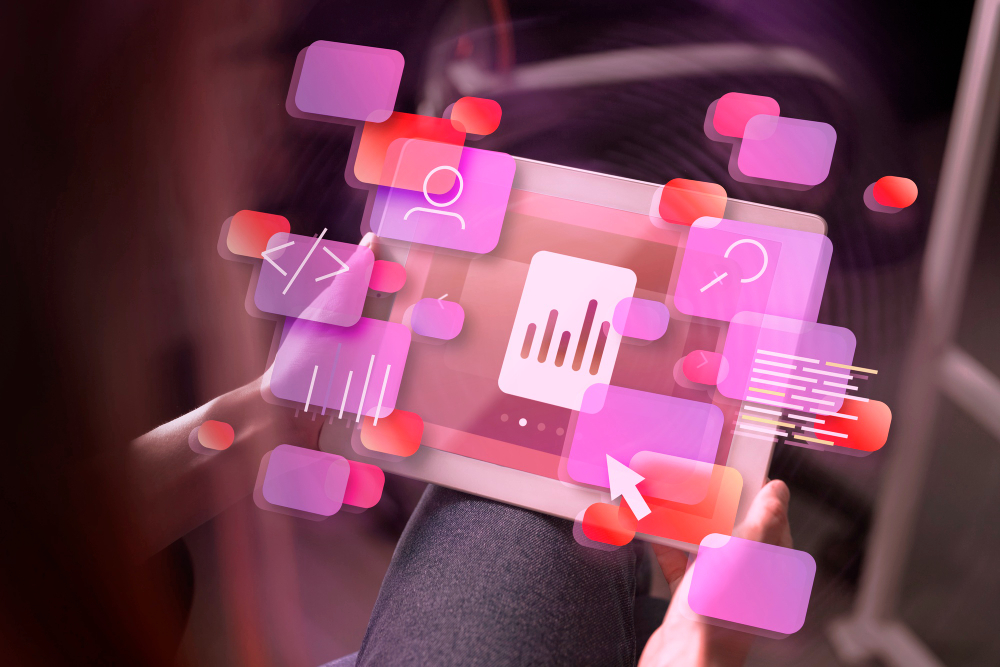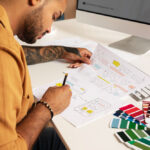UI design in 2025 is growing quickly, thanks to better AI, a stronger focus on personalization, and users expecting simple, smooth online experiences. From bold visual expressions to calming, minimalist interactions, the digital interfaces we engage with are undergoing transformative changes. If you’re a designer, developer, or brand strategist, focusing on these UI trends is key to delivering relevant and engaging user experiences.
Here, we will see what’s in and what’s being phased out in UI design in 2025.
What’s In: The Emerging UI Trends of 2025
1. AI-Generated Design and Generative Videos
AI is changing the way digital design works by making tasks easier and offering endless design options. By 2026, it will help with things like choosing layouts, colors, and even building complete branding systems. While AI will handle repetitive work, human creativity will still play a key role. Designers will spend more time making big-picture decisions and picking the best AI-generated ideas for each project.
Tools like Adobe and Figma already use AI to help designers work faster, be more creative, and achieve greater accuracy.
2. Dynamic, Fluid Typography
Typography will remain a major design focus in 2025, becoming more flexible and responsive. Variable fonts will adjust smoothly to different screen sizes and user settings, making text easier to read across devices. Text will also become more interactive, changing with scrolls, hovers, or voice commands, to create a more engaging user experience.
3. High Contrast
In 2025, bold contrast will dominate design trends, with striking combinations like dark blue paired with neon orange making waves across digital and print mediums. These high-impact color schemes create visual stress that grabs attention and communicates energy, confidence, and modernity. Perfect for branding, UI design, and advertising, these palettes are especially effective for clipping through digital noise, ensuring designs stand out on screens and in physical spaces alike. High contrast isn’t just eye-catching, it’s a statement of boldness and clarity.
4. Motion Posters
Motion posters will bring a fresh, dynamic advantage to graphic design in 2025, blending the impact of static visuals with fine, looped animations. Perfect for advertising, social media, and events, these posters add just enough movement to capture attention without overwhelming. Ideal for brand promotions and product launches, motion posters are set to become a go-to for storytelling that’s both eye-catching and memorable, helping brands stand out in the digital field.
5. 3D and Immersive Interfaces
3D elements and immersive interfaces, powered by AR and VR, will shape digital experiences. In 2025, users will expect 3D models, spatial navigation, and interactive animations to create a more engaging user journey, particularly in E-commerce and gaming platforms. These designs will not only improve visual appeal but also add new dimensions to UI/UX, pushing beyond the limits of flat, two-dimensional spaces.
6. Minimalist Logos
In 2025, logo design trends will reflect a mix of simplicity, adaptability, and personality, integrating with the growing needs of digital-first brands and versatile platforms. This style keeps logos clean and modern while adding an element of surprise that grabs attention.
With more brands moving to wordmarks or letter-based logos, typography will take center stage. Designers will experiment with custom typefaces, unique ligatures, and abstract letterforms to make logos stand out with just the brand name.
What’s Out: Trends Losing Ground in 2025
1. One-Size-Fits-All Design
Generic templates that fail to adapt to individual needs or contexts are quickly becoming outdated. Users want more than a generic experience; they desire personalized journeys that reflect who they are and how they interact with content. Designers who don’t keep up with this change might lose users to others with more user-friendly and flexible designs.
2. Overly Flat and Skeuomorphic Extremes
While flat design helped simplify cluttered interfaces, its dominance is fading. On the other hand, skeuomorphism (making digital items resemble real-world objects) hasn’t fully returned either.
Today’s users want slight depth and realism, but not at the cost of clarity or performance. Ultra-flat or overly literal design elements are being replaced by hybrid styles, ones that prioritize usability with tasteful, modern aesthetics.
3. Pop-Ups and Interruptive UX
Nothing drives users away faster than a nosy pop-up. In 2025, UI is running clear of interruptive elements like auto-playing videos, aggressive banners, or full-screen takeover modals.
Instead, minimal notifications, context-aware tooltips, and inline messaging provide smoother communication without breaking the experience.
4. Static Navigation Menus
Static menus that stay the same for every user are being replaced with smart navigation that adapts in real time. If it’s a hamburger menu that changes based on screen size or shortcuts customized to your recent activity, the future of navigation is dynamic. Rigid navbars that don’t grow with user behavior feel outdated nowadays.
5. Overuse of Stock Icons and Generic Illustrations
Stock assets are no longer good enough. Brands want personality, and users look for authenticity. In 2025, generic icons and illustrations are giving way to customized visuals and brand-specific motion graphics. Custom visuals not only boost engagement but also make your product or brand more memorable.
UI design in 2025 is less about aesthetics alone and more about contextual intelligence, interfaces that respond, adapt, and respect the user. If it’s using AI for personalization, using voice and spatial computing, or reimagining inclusivity, the trends shaping this year are practical, emotional, and visionary. What’s out are the old assumptions: that users will adapt to your website design. What’s in is designing systems that adapt to users with empathy, intelligence, and intent.
In digital interaction, one thing is clear: the best UI isn’t just easy to use, it connects on a human level.




